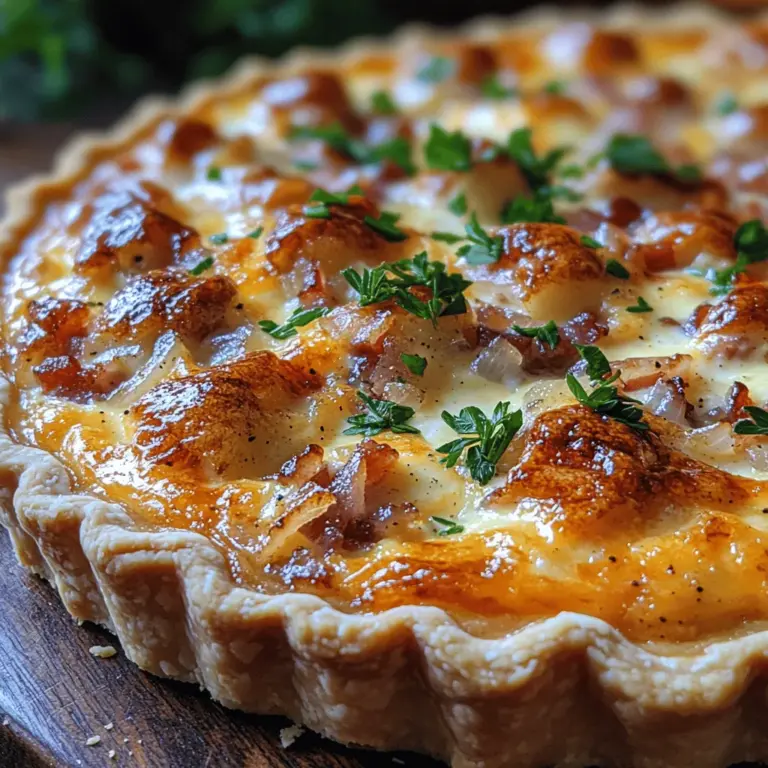Quiche Lorraine is more than just a dish; it’s a culinary tradition that has transcended borders and delighted taste buds for generations. Originating from the Lorraine region in northeastern France, this savory tart combines a rich custard base with a medley of ingredients that create an explosion of flavors and textures. The classic Quiche Lorraine features a delicate balance of creamy custard, nutty Gruyère cheese, and crispy bacon, making it a versatile choice for breakfast, brunch, or even a light dinner. In this article, we will explore the nuances of making Quiche Lorraine Delight, a recipe that elevates the traditional quiche to new heights.
The appeal of quiche lies in its adaptability; it can be enjoyed warm or cold, making it ideal for any occasion. Whether served at a lavish brunch or a cozy family gathering, this dish is sure to impress. The combination of Gruyère cheese and bacon in this particular recipe sets it apart, offering a flavor profile that is both savory and indulgent. As we embark on this culinary journey, you will discover the step-by-step process to create this delightful quiche, ensuring that you can impress your family and friends with your culinary skills.
Understanding Quiche Lorraine
To fully appreciate the Quiche Lorraine, we should delve into its rich history and cultural significance. The origins of quiche can be traced back to the medieval German kingdom of Lothringen, which later became part of France. The original recipe featured a simple custard filling made with eggs and cream, baked in a pastry crust. Over time, the dish evolved, incorporating local ingredients, ultimately giving birth to the beloved Quiche Lorraine we know today.
Traditionally, Quiche Lorraine was made with smoked bacon or lardons, combined with a creamy custard filling of eggs and heavy cream. In modern variations, Gruyère cheese has become a staple ingredient, adding depth and richness to the quiche. There are countless adaptations of quiche, with ingredients ranging from vegetables to seafood, but the classic combination of bacon and cheese remains a timeless favorite.
The flavor profile of Quiche Lorraine is characterized by its creamy texture and the savory notes of its key ingredients. Gruyère cheese, known for its slightly nutty and sweet flavor, melts beautifully, providing a luscious creaminess to the custard. The addition of bacon introduces a smoky and salty element that enhances the overall taste of the quiche. Together, these ingredients create a harmonious balance that is both comforting and satisfying.
Ingredient Breakdown
Before diving into the preparation of our Quiche Lorraine Delight, let’s take a closer look at the key ingredients that make this dish so special.
Pre-Made Pie Crust
For convenience, many choose to use a pre-made pie crust when making quiche. This saves time and effort, allowing you to focus on the filling. When selecting a store-bought crust, look for one that is made with high-quality ingredients to ensure the best flavor and texture. Alternatively, if you prefer a homemade approach, a simple pastry dough made with flour, butter, and water can be easily prepared. This option allows for customization and control over the thickness and flakiness of the crust.
Eggs, Heavy Cream, and Whole Milk
The custard filling is the heart of any quiche, and it is primarily made from eggs, heavy cream, and whole milk. Eggs provide structure and stability to the filling, while heavy cream and whole milk contribute to its richness and creaminess. The combination of these dairy products creates a velvety custard that is both satisfying and indulgent. The ratio of cream to milk can be adjusted based on personal preference; using more cream will yield a richer quiche, while more milk will result in a lighter texture.
Gruyère Cheese
Gruyère cheese is a star ingredient in Quiche Lorraine. This Swiss cheese is known for its smooth melting properties and complex flavor, which ranges from nutty to slightly sweet. When melted, Gruyère becomes creamy and enhances the overall richness of the quiche. If Gruyère is not available, other cheeses such as Emmental or a sharp cheddar can be used, but the flavor profile will vary.
Bacon and Onions
Bacon is essential to the classic Quiche Lorraine, providing a crispy texture and savory depth of flavor. When cooked, bacon releases its fat, which adds richness to the custard. For the best results, opt for high-quality bacon that is meaty and flavorful. Onions, when sautéed to golden perfection, add a sweet and aromatic element to the quiche. Caramelizing the onions enhances their natural sugars, resulting in a rich and savory base that complements the bacon and cheese beautifully.
Seasonings: Nutmeg, Salt, and Pepper
Seasoning is crucial in elevating the flavors of your Quiche Lorraine. A pinch of nutmeg adds warmth and depth, while salt and pepper enhance the overall taste. Be careful not to over-season, as the bacon and cheese already contribute saltiness to the dish. Adjust the seasonings based on your taste preferences, and don’t hesitate to experiment to find the perfect balance for your quiche.
Fresh Parsley
For a touch of freshness and visual appeal, fresh parsley is often used as a garnish for the finished quiche. Its vibrant green color contrasts beautifully with the golden custard and adds a mild, herbal flavor that brightens the dish. While parsley is optional, it can enhance the presentation and elevate the overall dining experience.
Step-by-Step Instructions
Now that we have a deeper understanding of the ingredients, let’s explore the step-by-step process of preparing Quiche Lorraine Delight. Each stage is vital in achieving the perfect quiche, so follow along carefully.
Preheat the Oven
Before you begin assembling the quiche, it’s essential to preheat your oven to 375°F (190°C). Preheating ensures that the quiche bakes evenly and achieves the desired texture. An oven that is not hot enough can result in a soggy crust and improperly set custard, so don’t skip this crucial step.
Preparing the Pie Crust
If using a pre-made pie crust, remove it from the packaging and place it in a pie dish. Gently press the crust into the dish, making sure to avoid stretching it, which can cause it to shrink during baking. To prevent bubbling, use a fork to poke holes in the bottom of the crust. This allows steam to escape and helps maintain a flat surface.
If you opt for a homemade crust, roll out the dough on a lightly floured surface until it is about 1/8-inch thick. Carefully transfer it to the pie dish, trimming any excess dough that hangs over the edges. Again, poke holes in the bottom and edges of the crust to prevent bubbling. For added security, consider lining the crust with parchment paper and filling it with pie weights or dried beans while it bakes to keep it in place.
Sautéing the Onions
In a skillet over medium heat, add a tablespoon of butter or oil and allow it to melt. Once hot, add the diced onions and sauté, stirring occasionally, until they become soft and golden brown. This process usually takes about 8-10 minutes. The caramelization of the onions adds a rich sweetness that complements the savory flavors of the bacon and cheese. Once cooked, remove the onions from the heat and set aside to cool slightly.
Cooking the Bacon
In the same skillet, add the diced bacon and cook over medium heat until it is crispy and browned. This will take about 5-7 minutes. The rendered bacon fat not only adds flavor but can also be used in the custard mixture if desired. Once cooked, use a slotted spoon to transfer the bacon to a plate lined with paper towels to drain excess grease.
With the oven preheated, the crust prepared, and the filling components sautéed, you are now ready to move on to the next steps of assembling and baking your Quiche Lorraine Delight. As you continue through this recipe, the delightful aroma of the baking quiche will fill your kitchen, creating anticipation for the delicious meal that awaits.
{{image_1}}
Mixing the Egg Mixture
To create the perfect Quiche Lorraine, the egg mixture is a crucial component that binds the entire dish together. Start by cracking four large eggs into a mixing bowl. Using a whisk, beat the eggs thoroughly until the yolks and whites are completely combined. This step is essential; a well-mixed egg blend helps prevent separation, ensuring a silky texture throughout your quiche. Add in one cup of heavy cream or half-and-half, which will lend richness to the filling. Whisk this in until fully integrated.
Don’t forget to season your egg mixture! A pinch of salt and a few cracks of black pepper enhance the flavor of the eggs. For an added layer of complexity, consider incorporating a pinch of nutmeg—this subtle spice complements the creamy filling beautifully. Whisk the mixture again until everything is uniform. The key here is to ensure that air is incorporated, as this will help the quiche rise slightly while baking.
Combining the Filling Ingredients
Next, it’s time to bring together the filling ingredients that will give your Quiche Lorraine its signature taste. In a separate bowl, take one cup of cooked and crumbled bacon, which adds a savory depth to the dish. If you prefer a lighter option, feel free to substitute with sautéed mushrooms or spinach for a vegetarian twist.
Add one cup of shredded Swiss cheese to the bacon. This cheese not only enriches the flavor but also provides that classic melty texture. For an even flavor distribution, toss the bacon and cheese together gently to ensure every bite will have a taste of both. If desired, finely chop a small onion and sauté it in a bit of olive oil until translucent, then mix it in with the bacon and cheese for added sweetness.
Once the filling is ready, pour the egg mixture over it. Use a spatula to gently fold the ingredients together, ensuring that the bacon and cheese are evenly dispersed throughout the egg mixture. This careful combination ensures consistent flavor in every slice of your quiche.
Assembling the Quiche
Now that your filling is ready, it’s time to assemble your Quiche Lorraine. Preheat your oven to 375°F (190°C) if you haven’t already. If you’re using a store-bought pie crust, make sure it’s thawed if frozen, and fit it into a 9-inch pie plate. If you’re making your own crust, roll it out to fit your dish, ensuring it has an even thickness.
Pour the egg and filling mixture into the prepared crust. To prevent spills, place the pie plate on a baking sheet before pouring. This makes it easier to transfer to the oven and catches any potential drips. Use a spatula to spread the mixture gently, ensuring an even layer across the crust.
Baking Process
With the quiche assembled, it’s time to bake. Slide the baking sheet into your preheated oven and set a timer for 30 to 35 minutes. Keep an eye on it; the quiche is ready when the edges are set and the center has a slight jiggle but is no longer liquid. A knife inserted into the center should come out clean.
To avoid overbaking, consider checking the quiche around the 30-minute mark. Overbaking can lead to a dry texture, so if you notice the edges are browning too quickly, you can cover the pie with aluminum foil for the remaining baking time. Once done, remove the quiche from the oven and allow it to cool for about 10-15 minutes before slicing.
Presentation and Serving Suggestions
After cooling, it’s time to slice and serve your Quiche Lorraine. Use a sharp knife to cut it into wedges, making sure to go all the way through the crust for clean edges. The quiche can be enjoyed warm or at room temperature, making it an excellent dish for brunch or a light lunch.
For serving, consider pairing your quiche with a simple green salad tossed in a light vinaigrette. The crispness of fresh greens balances the richness of the quiche beautifully. Alternatively, serve it alongside roasted vegetables or a fruit salad for a delightful contrast in flavors.
To elevate your presentation, garnish each slice with fresh herbs such as chives or parsley. Not only do they add a pop of color, but they also enhance the flavor profile, bringing a fresh note to the rich quiche.
Nutritional Information and Benefits
Quiche Lorraine is not only delicious but also offers a variety of nutritional benefits. Each serving provides a good source of protein, thanks to the eggs and bacon, making it a filling and satisfying meal. The inclusion of Swiss cheese adds calcium and necessary fats, contributing to bone health and energy levels.
Additionally, if you incorporate vegetables into your quiche, you boost its vitamin content significantly. Leafy greens like spinach or broccoli can provide essential vitamins A, C, and K, as well as dietary fiber, which is beneficial for digestion.
When enjoyed in moderation, Quiche Lorraine can be part of a balanced diet. Pair it with nutrient-rich sides to create a well-rounded meal.
Variations and Customizations
Quiche Lorraine is wonderfully versatile, allowing for various adaptations to suit different dietary preferences. For a vegetarian option, omit the bacon and replace it with a combination of sautéed vegetables such as bell peppers, zucchini, or mushrooms. You can also experiment with different cheeses—cheddar, feta, or goat cheese can add unique flavors.
If you’re looking for a gluten-free option, consider using a gluten-free crust or even a crustless quiche approach. Simply grease your pie plate and pour the filling directly into it. The eggs will set and hold everything together without the need for a crust.
Seasonal ingredients can also be incorporated to refresh the dish throughout the year. For instance, adding asparagus in spring, tomatoes in summer, or roasted squash in fall can keep your Quiche Lorraine exciting and new.
Conclusion: The Joy of Making and Sharing Quiche Lorraine
Making Quiche Lorraine is not just about following a recipe; it’s about embracing the joy of cooking and sharing food with loved ones. The process of preparing this dish—from mixing the egg filling to carefully baking it to golden perfection—can be a satisfying and rewarding experience.
As you slice into the quiche and serve it to friends and family, you’ll find that its rich flavors and comforting texture make it a beloved addition to any meal. Whether enjoyed at breakfast, brunch, or as a light dinner, Quiche Lorraine is a timeless classic that invites creativity in the kitchen.
So, whether you’re sticking to tradition or experimenting with new ingredients, embrace the art of quiche-making. Gather your loved ones around the table and let the delicious aroma of homemade quiche fill your home, creating memories that will last long after the last slice is gone. Enjoy the process and the delightful flavors that come with this beloved dish!


